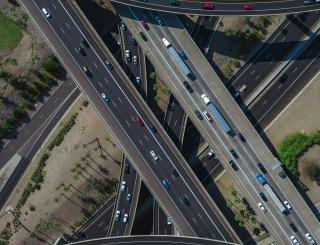Getting the Jump on Electric Supply and Demand for Medium-and Heavy-Duty Vehicles

This blog was featured in the inaugural edition Energy Driven, a bimonthly publication of Trio’s Transportation Electrification team delivering timely, impactful news happening across the evolving transportation sector. Click here to sign up and get Energy Driven directly to your inbox.
Enticing incentives, sleek technology, and environmental benefits are just a few of the factors driving greater adoption of electric vehicles (EVs). With passenger, or light-duty, EVs finding their groove in the transportation industry, the electrification transition has begun to turn more towards medium- and heavy-duty vehicles (MHDVs).
We are all aware of how much we rely on these vehicles to transport petroleum, packages, and people each day. What is slightly more surprising, however, is that while MHDVs make up just 4% of vehicles on the road, they account for 26% of U.S. transportation related greenhouse gas emissions (GHGs).
Pressure from legislators and consumers have compelled enterprises to consider transitioning away from their diesel fleets to reduce GHG and tailpipe emissions, as well as to move closer towards their corporate social responsibility goals.
One thing to note, however, is that internal pressure for companies to improve their bottom line and hedge against future uncertainty has always been present. MHDV commercial vehicles are business assets expected to generate a return, and their electric counterparts can potentially bring about greater efficiency, reduced fuel price volatility, and a lower total cost of ownership.
To meet growing EV demand, several major manufacturers, along with some start-ups, have announced or released their own electric MHDV models. As we continue to prepare for a fully electric future, we must plan for all potential impacts, including an increase in electricity demand when millions of vehicles are charging at once – especially since MHDVs have a higher energy density and greater energy needs.
Electricity Supply and Demand
As U.S. sales and registrations of MHDVs continue to rise, so too will electricity demand to charge vehicles. This is a result of increased charging frequency due to varying battery capacities, travel routes, and payloads of MHDVs. Just as you need to refuel an internal combustion engine (ICE) vehicle, you must recharge an EV.
Typically, direct-current fast-charging (DCFC) stations are utilized when charging MHDVs, which on average have an output range of between 50kW and 350kW per hour. This allows for an expedited charge for a range of 20-70 miles per 20-30 minutes of charge.
As an example, charging the Tesla Semi long-haul truck with a range of 500 miles, with an efficiency of 1.7 kWh per mile, would take approximately 3.5 hours (1,225 kW) to fully charge using the maximum output. In addition, while not in use (idle), DCFC chargers utilize between 0.5-1.0 kW.
In other words, power is being used around the clock to either support or fully fuel EVs and their infrastructure. Assuming all MHDV had the same efficiency of 1.7 kWh per mile, there would need to be 539.24 Terawatt-hours of energy needed for charging (or 539,240,000,000,000 watt-hours) – roughly equivalent to the annual energy of 50.7 million single family homes.
This isn’t as improbable as it may seem, considering that electrification agendas proposed by local, state, and national governments aim to either fully transition or phase in zero-emission EVs by 2035 or 2050. While this shift won’t happen overnight, the need to accommodate EVs and their charging infrastructure is quickly approaching, as is the need to find solutions to growing dependence on the electrical grid.
While the amount of charging power needed may sound astronomical, the question is: how can we mitigate the impact of MHDV charging activities on what some have seen as an already overworked power grid?
Potential Solutions
- Distributed Energy Resources (DERs) are modular energy generation technologies, such as solar arrays, small wind farms, and battery energy storage systems, located on the consumer’s side of the meter. These generation sources can partially or fully reduce electricity demand, as they provide their own power and may even provide supply to the distribution grid.
- Battery Energy Storage Systems (BESS) are devices that enable energy from renewables to be stored and released when customers need power. When implemented onsite, these systems can charge and discharge using direct current (DC) and connect to the grid through an inverter. Costs are lowered when the battery charges from the grid and stores the electricity, releasing it when the demand is higher – also known as “peak shaving.” The battery delivers electricity to the vehicle without drawing power from the grid. These systems can be actively managed to not only reduce demand charges but to reduce the impacts that vehicle charging has on the electric grid.
- Demand response, as it relates to transportation electrification, is a customer-focused approach that encourages EV owners to become more vigilant about their charging schedule, i.e., reducing the use of electricity during hours that are seen as peak periods. Financial incentives, including time-based rates, can reduce electricity costs, which in turn lowers retail rates, enticing consumers to participate in demand response programs, according to the Department of Energy (DOE). This is a method already used by utilities during times when the grid is constrained, or when there is lots of power being pulled from the grid.
- Managed Electric Vehicle Charging (load management or off-peak charging) assists in allocating power on an as-needed basis, reducing electricity consumption. This can be accomplished in two ways: smart charging or human planning, which the DOE describes as an automated adjustment of power levels or shift in the session charging, or the optimization of charging – reducing the needs for EVSE (electric vehicle supply equipment) deployment through proper scheduling by on-site personnel, respectively. By using software to optimize your fleet’s charging schedule, you can reduce your costs by charging when energy is at its lowest cost. This ensures that the total charging load does not exceed your capacity limits, avoiding extra costs known as demand charges – all while ensuring that your operational requirements are appropriately met.
Key Takeaways
- With an increase in EVs, particularly MHDVs, there will be more electricity required to charge those vehicles.
- Understanding the power supply and loads required to support your selected MHDVs and their charging infrastructure will help you manage your electricity demand.
- Consider accompanying selected EVSE with DER and other load management strategies to offset costs and improve grid resilience.
The electrified future of heavy-duty vehicles is likely closer than we think, as indicated by global sales of electric medium- and heavy-duty trucks in 2021, which more than doubled over 2020 volumes, while total sales volumes remained the same as the previous year.
As policies continue to be implemented, incentives become readily available, and capital costs for vehicles drop, we anticipate that the current trajectory will continue. It will be critical to remain “two-steps ahead” and to prepare for the implications of vehicle electrification, particularly added capacity.
Ready to start your organization’s electrification journey? Please reach out to Sage McLaughlin, Director Business Development.
For more information, check out our Transportation Electrification Blog Series.
